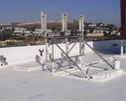During roofing work, roofing contracting companies use a wide variety of motor vehicles to transport workers, materials and equipment to job sites. Depending on a project's nature and vehicles' sizes and contents, a roofing contractor's motor vehicles and the drivers he or she employs may be regulated by the Department of Transportation Federal Motor Carrier Safety Administration (FMCSA).
You likely are aware of most FMCSA regulations. However, some regulations may not be as well-known, and the consequences of noncompliance can be significant.
CDL requirements
A commercial driver's license (CDL) is a special license issued by individual states based on minimum FMCSA qualification standards that allows a driver to operate large trucks and buses. Drivers of certain commercial motor vehicles (CMVs) may obtain special endorsements to their CDLs by passing additional tests authorizing them, for example, to drive tanker vehicles or transport hazardous materials.
Most commonly in the roofing industry, CDLs are categorized by three classes of licenses based on the type of vehicle or combination of vehicles (for instance, towed trailers) the driver operates:
- Class A—any combination of vehicles with a gross combination weight rating of 26,001 pounds or more if the vehicle being towed has a gross vehicle weight rating greater than 10,000 pounds
- Class B—any single vehicle with a gross vehicle weight rating of 26,001 pounds or more or any such vehicle towing a vehicle with a gross vehicle weight rating of 10,000 pounds or less
- Class C—a vehicle or combination of vehicles not meeting the definition of Class A or B transporting a quantity of hazardous materials for which a placard is required
Vehicle placards generally are required on vehicles carrying more than 1,001 pounds of hazardous materials. Common hazardous materials in roofing include flammable adhesives and coatings, propane, and flammable and combustible solvents. Hot asphalt is not subject to the placard rules; rather, it is a Class 9 hazardous material.
Drivers may run afoul of CDL requirements by loading their vehicles with an aggregate of more than 1,001 pounds of hazardous materials.
Driving restrictions
Hours-of-service (HOS) regulations establish the maximum time a driver may operate a CMV, as well as required off-duty time. HOS rules apply to property-carrying CMVs used in interstate commerce in a business if the CMV weighs 10,001 pounds or more or has a gross vehicle weight rating or gross combination weight rating of 10,001 pounds or more.
A vehicle operating in interstate or intrastate commerce that is transporting hazardous materials in a quantity requiring a placard is considered a CMV under FMCSA rules, and drivers of such vehicles must follow HOS regulations.
A CMV driver subject to HOS rules may drive a maximum of 11 hours after 10 consecutive hours off duty and may not drive at any point after the 14th consecutive hour after coming on duty following 10 consecutive hours off duty.
For example, a CMV driver who starts driving at 6:00 a.m. and stops driving at 2:00 p.m. has three remaining hours of driving allowed in the current driving period. However, after 8:00 p.m., the driver is not allowed to drive until he or she has completed 10 consecutive off-duty hours.
Avoid fines
Civil fines for noncompliance under FMCSA rules can be substantial; violations of HOS regulations range from $1,000 to $11,000, and an employer who violates certain CMV rules may be subject to a fine as high as $25,000. Make sure you manage your vehicles, drivers and transported materials cautiously to avoid such penalties.
Harry Dietz is NRCA's director of risk management.



